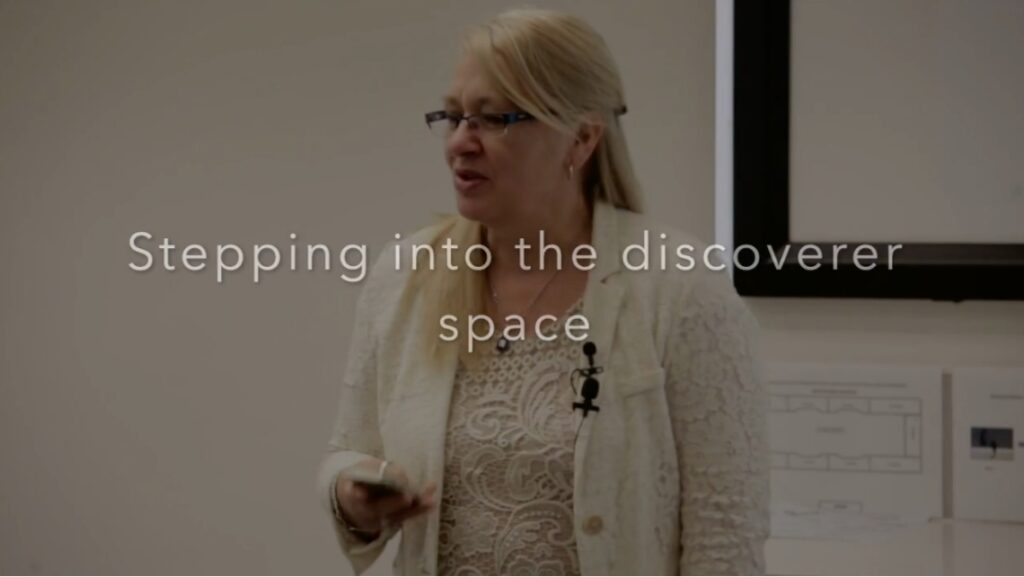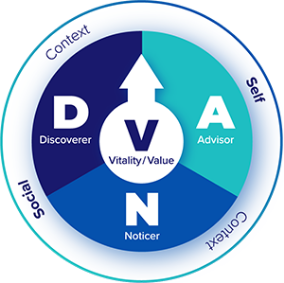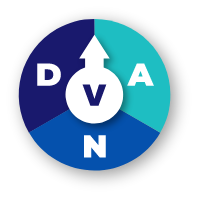DNA-V Video and Audio Resources
Dream big! Learn the DNA-V steps
Below is a series of simple videos that can help introduce young people to their DNA-V. Now you will have a way to show young people, inspire them, fire them. The videos can provide the springboard for counselling or classroom discussions.
DNA-V starts with the simple premise that we humans have much more potential than we can ever express in one moment. We are more like fire than stone. We are never complete, never broken, and always capable of growth.
DNA-V synthesises the behaviours found in all humans – we all have this kind of DNA just as we all have DNA in our cells. DNA-V is based on the latest evidence base and provides a dynamic model that can support personal growth and improve psychological problems. DNA-V uses the effective elements found in all therapies and psychological interventions.
D, N, and A stand for discoverer, noticer, and advisor – three classes of behaviour, or less technically: “Ways of being, or spaces, that we can move between.” We can learn to flexibly move between DNA to become more skilled at each, and use them to create a life with heart – value and vitality (the V).
We can help people become DNA-V shifters – able to flexibly move around and choose the behaviour that best fits the situation.
DNA-V is a simple way of helping young people learn about the skills they have inside them. This video explains the first steps.
Advisor
The advisor represents our inner voice. It is an incredible skill that helps us humans navigate the world efficiently. In contrast to the discoverer, the advisor space is about avoiding trial and error. It involves judging, evaluating, generating rules, listening to our self-talk, and problem-solving. The advisor can become a problem if we use it blindly, we can lose contact with the physical world and use worry, rumination, our own self-talk or rules even if they do not help us grow. DNA-V can be used to train skilled advisors.
Noticer
The noticer represents a group of behaviours all humans are born with. This is the space where we notice what is going on inside our bodies and what is going on in the outside world. Noticing helps us to identify and use information from the world. We learn to notice incoming messages, attend to them, and respond to them or allow them to come and go without responding. For example, we notice our anger, and decide then how best to act, rather than merely reacting to our anger. Skilled noticers are able to appreciate the present moment and respond to their noticer messages in ways that help them thrive.
Discoverer
The discoverer encapsulates how we humans are driven to explore and interact with the world through direct experience. This skill involves learning by trial and error. Stand up, fall down, stand up again. Discoverer can be a scary space, but it is also the place we move into if we want to broaden and build our life. We also go into discoverer if we want to fully engage with the physical world, as when an athlete gets into the full flow of a game or a carpenter is fully absorbed in making a beautiful table. In both of these examples, there is direct contact with physical reality and feedback about what is and is not working. Unskilled discoverers can get stuck repeating impulsive behaviours that have short-term payoffs but long-term costs. DNA-V can help young people to become skilled discoverers.
Access the interactive version of this Discoverer video.
Discoverer is a behavioural process that allows us to work with young people on risk taking, sensation seeking and love of novelty. The attached video shows how important it is for us to think about this as a developmental process that underpins growth.
We hope we can help them use their discoverer skills to enrich their life and our world. If we could honour adaptive risk taking in young people and help them grow into flexible humans, we could change the future.

The DNA-V model for young people – an introduction to our book, The Thriving Adolescent.
For schools
This video shows you how to use DNA-V in the situation of not attending school. However, it isn’t designed just for this one issue, it is designed as an exemplar for the discoverer. Show it to young people and then ask them to map this to their own struggle. Some questions:
- How is this like your advisor?
- How is this like your noticer?
- In the first part, the discoverer finds a solution that is helpful in the short term, but unhelpful in the long term. Do you do that too?
- How was the discoverer used differently the second time?
This video will provide a springboard for counselling or classroom discussions.
This little video shows how we use BOLD – the four steps to action you can read about in our books. See page 133 of The Thriving Adolescent.
This little video shows what goes on in secret inside our minds. Take note of how many you have had. The message is we are all the same.
Audio resources
Mindfulness exercises from The Thriving Adolescent:
Balloon breathing (see page 83)
3-minute breathing space (adapted from Seagal, Williams and Teasdale, 2002)
AND Noticer exercise (see page 70)
From our book, Get Out of Your Mind and Into Your Life for Teens: audio files of Jess’s and Sam’s stories – recorded by Kylie Smith at University of Canberra:
The DNA-V song, by Lisa Butcher.
Lisa is a talented musician and psychologist who is dedicated to helping young people.
Find out more about the training we offer to professionals, and about the science underpinning DNA-V.


